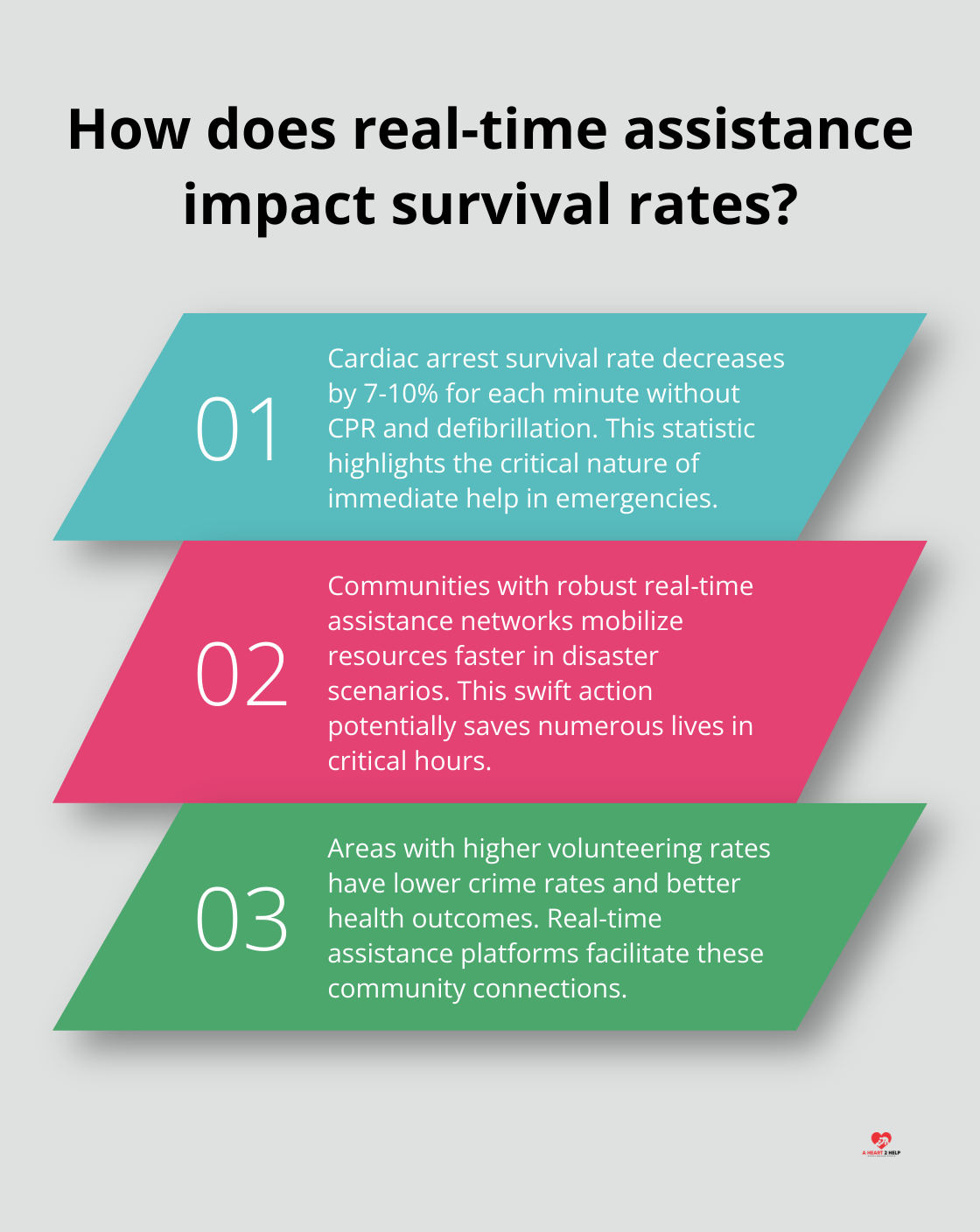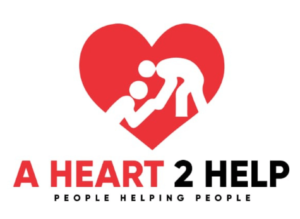Real-time assistance can make the difference between life and death in critical situations. At A Heart 2 Help, we’ve seen firsthand how immediate support can transform lives and strengthen communities.
In this post, we’ll explore effective strategies for providing real-time assistance and overcoming common challenges. We’ll also discuss how you can get involved in making a lasting impact through immediate help initiatives.
Why Real-Time Assistance Matters
Real-time assistance transforms crisis situations. When emergencies occur, every second counts. A study by the American Heart Association reveals that a cardiac arrest victim’s survival rate decreases by 7-10% for each minute without CPR and defibrillation. This statistic highlights the critical nature of immediate help.
Saving Lives Through Swift Action
Rapid response in disaster scenarios dramatically reduces casualties. Recovery core capabilities and critical recovery functions such as leadership, organizational and coordination are essential for effective disaster response. Communities with robust real-time assistance networks mobilize resources faster, potentially saving numerous lives in these critical hours.
Fostering Community Trust
Real-time assistance builds a foundation of trust within communities. When people know they can rely on immediate help, it creates a sense of security. A survey by the National Institute of Mental Health found that communities with strong support systems report lower levels of anxiety and depression. This improved mental health contributes to a more resilient and connected neighborhood.
Strengthening Community Bonds
Immediate support doesn’t just help in crises; it strengthens everyday community ties. The Corporation for National and Community Service reports that areas with higher volunteering rates have lower crime rates and better health outcomes. Real-time assistance platforms facilitate these connections, making it easier for people to offer and receive help when it’s most needed.
Enhancing Emergency Preparedness
Real-time assistance improves a community’s overall emergency preparedness. When individuals know how to access immediate help (through apps or local networks), they become more resilient in the face of unexpected events. This preparedness extends beyond individual emergencies to large-scale disasters, where coordinated real-time assistance can make a significant difference in response effectiveness.

Real-time assistance creates safer, more connected, and resilient communities. It’s not just about responding to emergencies; it’s about building a network of support that enhances daily life for everyone involved. As we move forward, let’s explore the effective strategies that make real-time support possible and impactful.
Strategies for Effective Real-Time Support
Real-time assistance requires a well-coordinated approach that combines technology, human resources, and clear communication. We’ve identified key strategies that significantly enhance the effectiveness of immediate support efforts.
Harnessing Technology for Rapid Response
Modern technology plays a pivotal role in facilitating quick and efficient real-time assistance. Mobile apps enable instant connections between those in need and potential helpers. These platforms use GPS technology to match requests with nearby volunteers, drastically reducing response times.

A report by the American Red Cross reveals that 69% of Americans believe emergency responders should monitor social media sites to send help. This statistic underscores the importance of integrating various digital platforms into real-time assistance strategies.
Advanced data analytics also contribute significantly. Organizations can predict high-demand periods and allocate resources more effectively by analyzing patterns in assistance requests. For instance, the New York City Fire Department uses predictive modeling to anticipate emergency call volumes. The committee explored geographic disparities in response times, hospital turnaround delays, and new initiatives like Hospital Liaison Officers.
Building a Robust Volunteer Network
A strong network of reliable volunteers forms the backbone of any real-time assistance system. Organizations should focus on creating flexible volunteering opportunities that cater to different schedules and skill sets. This approach increases participation rates and ensures a diverse pool of helpers.
Training is equally important. Regular workshops, online courses, and simulations can keep volunteers ready for various scenarios.
Recognizing volunteer efforts is also key to maintaining a strong network. A point system or featuring top volunteers can boost motivation and retention rates (which are essential for long-term success).
Implementing Clear Communication Protocols
Effective communication serves as the lifeline of real-time assistance. Clear, concise, and timely information flow ensures that help reaches those in need quickly and efficiently.
A centralized communication hub is essential. This could be a dedicated emergency hotline or a digital platform that coordinates all assistance requests and responses. The Federal Emergency Management Agency (FEMA) emphasizes the importance of a unified command structure in its National Incident Management System, which communities can adapt for local assistance programs.
Standardized communication protocols help minimize confusion during high-stress situations. This includes using clear, jargon-free language and implementing a system for prioritizing requests based on urgency.
Regular drills and simulations can help identify and address communication bottlenecks. These exercises should involve all stakeholders, from volunteers to local authorities, to ensure seamless coordination during actual emergencies.
The combination of cutting-edge technology, a dedicated volunteer network, and streamlined communication creates a robust framework for real-time support. However, even with these strategies in place, providing immediate assistance comes with its own set of challenges. In the next section, we’ll explore how to overcome these obstacles and ensure consistent, effective real-time support.
Navigating Challenges in Immediate Assistance
Real-time help presents unique obstacles. We have identified key challenges and developed strategies to overcome them, ensuring safe and effective assistance.
Prioritizing Safety in Volatile Situations
Safety stands as the top concern in real-time assistance. Construction professionals have higher injury rates than most other professions and experience some of the highest rates of alcohol abuse. To address this, organizations implement rigorous background checks and provide comprehensive safety training. For instance, many organizations offer free online courses on volunteer safety that cover risk assessment and personal protection strategies.

Some assistance platforms utilize a rating system within their apps, allowing both helpers and recipients to provide feedback. This creates accountability and helps identify potential risks. Additionally, partnerships with local law enforcement establish safe meeting points for in-person assistance, reducing the likelihood of dangerous situations.
Mitigating Stress in High-Pressure Scenarios
High-stress situations can impair decision-making and effectiveness. A study by the Journal of Traumatic Stress found that 24% of disaster response volunteers experience symptoms of post-traumatic stress disorder. To combat this, many organizations implement peer support systems within their volunteer networks.
Regular debriefing sessions after intense events help volunteers process their experiences. Access to professional counseling services also proves beneficial. The Substance Abuse and Mental Health Services Administration (SAMHSA) offers a free Disaster Distress Helpline, which volunteers often use when needed.
Maintaining Consistent Resource Availability
A steady supply of resources proves essential for effective real-time assistance. Organizations tackle this challenge through strategic partnerships and innovative resource management. For example, collaborations with local businesses create rotating schedules of resource donations, ensuring a consistent supply of essential items.
Predictive analytics anticipate resource needs. Analysis of historical data and current trends allows proactive stocking of necessary supplies before they’re needed. The Federal Emergency Management Agency (FEMA) uses similar methods in their Strategic National Stockpile program, which many local-level organizations adapt.
To address volunteer shortages during peak times, flexible scheduling systems allow volunteers to sign up for short shifts, increasing overall participation. Volunteer recruitment and retention strategies have been implemented through VGF grants to improve engagement.
Leveraging Technology for Enhanced Coordination
Advanced technology plays a vital role in overcoming real-time assistance challenges. Mobile apps with GPS capabilities (like A Heart 2 Help) match those in need with nearby volunteers, significantly reducing response times. These platforms also facilitate real-time communication and resource tracking.
Artificial Intelligence and machine learning algorithms help predict patterns in assistance requests, allowing for more efficient resource allocation. Some organizations use chatbots to handle initial inquiries, freeing up human volunteers for more complex tasks.
Ensuring Inclusivity and Accessibility
Real-time assistance must reach all members of a community, regardless of their circumstances. Organizations work to overcome language barriers by providing multilingual support and translation services. They also ensure their platforms are accessible to individuals with disabilities, following Web Content Accessibility Guidelines (WCAG).
Efforts to bridge the digital divide include partnerships with local libraries and community centers to provide access to technology. Some organizations (A Heart 2 Help included) offer offline options for requesting assistance, ensuring that those without internet access can still receive help when needed.
Final Thoughts
Real-time assistance transforms communities and saves lives. Technology, strong volunteer networks, and clear communication protocols help overcome the challenges of providing immediate help. Organizations must prioritize safety for volunteers and recipients, manage stress effectively, and maintain consistent resource availability to sustain these vital support systems.

The impact of real-time assistance extends beyond emergencies, fostering trust and strengthening community bonds. It creates a sense of security that improves every aspect of community life, reducing anxiety levels and enhancing health outcomes. Preparation, adaptability, and inclusivity are key to successful real-time assistance, ensuring help reaches those in need quickly and efficiently.
We urge everyone to participate in real-time assistance initiatives. Your skills and time can build a stronger, more supportive community. A Heart 2 Help connects those in need with helpers easily. Together, we can create a world where immediate help is always within reach.

